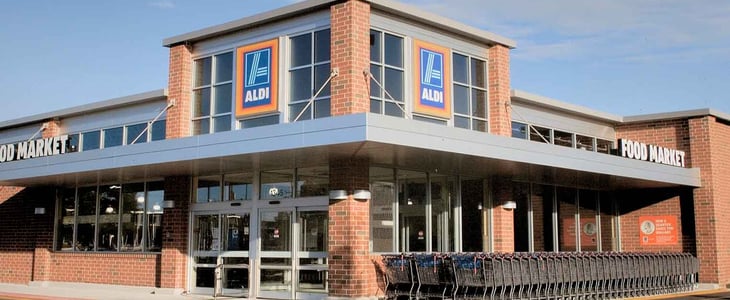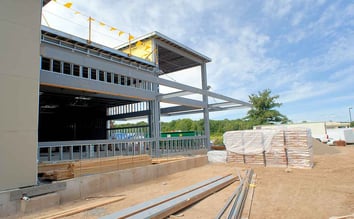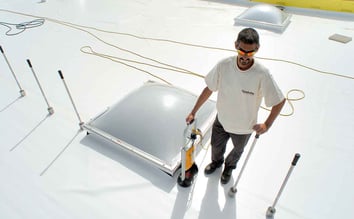Aldi, Inc.
New York, USA
Project Details
- Location
- New York, USA
- Project Year
- 2009
Aldi, Inc. is an international grocery retailer with approximately 1,000 stores in 29 states across the U.S. The company is ranked 25th among U.S. grocery chains in gross sales and has grown dramatically since it was established in the mid 1970s. Aldi specializes in providing a select assortment of the most frequently purchased grocery and household items, and sells them in manageable, non-bulk, sizes at prices that are up to 50% lower than traditional supermarkets.
During the past few years, Aldi has aggressively expanded its operations, opening 50 to 100 new stores in the U.S. each year. In 2009, the company plans to open approximately 75 new stores, including two in upstate New York – one in Farmington, the other in Springville.
Aldi stores are virtually all built to the same specifications. Each store is approximately 16,000 square feet, and designed to be efficient, both for shoppers as well as from an overhead and energy perspective. The facility includes a raised clearstory atrium in the front corner of the building over the entrance, as well as canopies extending from the entrance way along two sides of the structure.
One of the critical elements of Aldi construction is the floor. Aldi uses a special imported tile floor that is installed by a crew that travels between projects. So getting the roof system installed is critical to the construction schedule.
“The floor installation schedule is very rigid and established months in advance,” said Dave Pastore, CEO of Upstate Roofing & Painting. “The roof must be fully watertight in time to accommodate the flooring schedule.”
Upstate Roofing & Painting, a RoofConnect contractor, is a 35-year-old full service commercial roofing and painting company based in Rochester, NY. The company was hired to install the roofs on both the Farmington and Springville stores.
The roof on the Farmington, NY store is 16,400 sq. ft. and consists of a 22 gage steel deck with a ¼-inch per foot slope. In addition to a handful of individual pipe and drain penetrations, there are 27 large skylights on the roof. Each is approximately four-feet square and provides significant natural daylight to the store below. A parapet wall ranging in height from 18- to 20-inches surrounds the roof.
The roof specified for these projects was a Sika Sarnafil RhinoBond system with two layers of polyisocyanurate insulation and a 60 mil white PVC membrane.
RhinoBond is an alternative attachment system for installing thermoplastic membranes. The system, developed by OMG Roofing Products of Agawam, Mass., uses advanced induction welding technology to weld the membrane directly to specially coated plates used to secure the insulation or cover board to the deck. The result is a roofing system that eliminates membrane fastener penetration and uses fewer plates and fasteners while enhancing the wind uplift resistance.
More important, with the RhinoBond system, the membrane can be fully installed before all of the plates are bonded to the membrane, thus enabling the contractor to dry-in the facility quickly.
The RhinoBond system uses a patented stand-up induction welding tool to bond the underside of the membrane to the specially coated plates. Welds typically take five seconds each to complete and a magnetic cooling clamp is immediately placed onto the welded plate to assure a strong bond. For a roof system requiring a 1-90 rating, the system requires ten fewer fasteners and plates per square when compared to a typical in-seam mechanically attached system using a 10-foot-wide membrane fastened 12-inches on center.
For the Farmington store, two layers of 2-inch polyisocyanurate were installed using 5-inch fasteners. Six fasteners were used per 4 x 8 board in the field of the roof with enhancements in the corners and around the perimeter. In addition, Upstate Roofing & Painting installed crickets to drains and overflow scuppers. In total, approximately 6,000 RhinoBond plates were used for the installation.
“Springville was our first Rhino- Bond project,” said Pastore. “The tool is very easy to use and operate, but you have to layout the project a bit differently. OMG Roofing Products trained our crew before the project, so we went through the learning curve quickly, and had good productivity on the Springville store and even better productivity on the Farmington store.”
To keep on track, Upstate Roofing & Painting used a crew of eight and focused on installing the insulation on the first and second days. As soon as it was feasible on day one, they started to install the membrane, hot-air welding the seams and bonding some of the RhinoBond plates to keep the membrane securely in place. By the end of day two, the store was essentially dried in, leaving day three to bond the remaining RhinoBond plates and finish the last details.
“The key to a good RhinoBond job is installing the fasteners in a nice even grid pattern,” said Dan Pastore, field superintendent for Upstate Roofing & Painting. “Finding the plates under the membrane is easy if they are laid out correctly.”
The grid pattern distributes the wind uplift load over the entire roof surface rather than having it concentrated in the seams of the membrane in a linear fastening mode. This reduces the likelihood of point loading and minimizes sheet flutter. Furthermore, with this system, membrane width is not a factor and perimeter half sheets are not necessary, so there are also fewer seams to make.
“The RhinoBond System is fast and efficient to install and makes a great looking roof,” said Dan Pastore. “More importantly, our guys really like installing this system, and when they’re happy, everyone is happy!”





